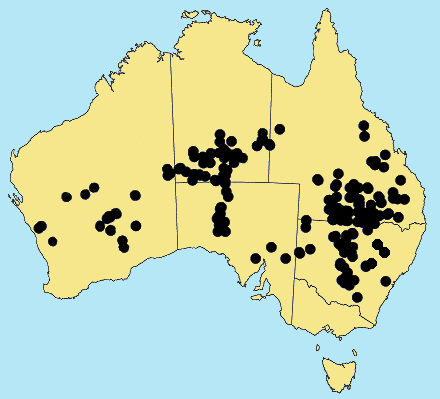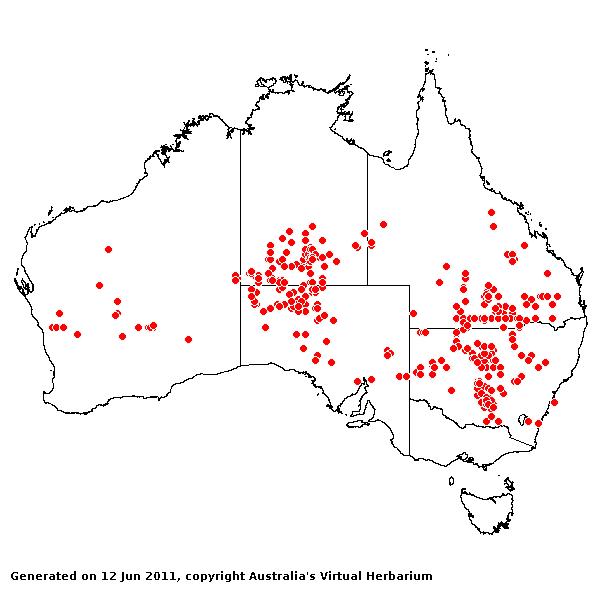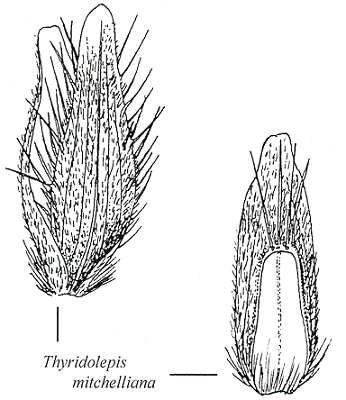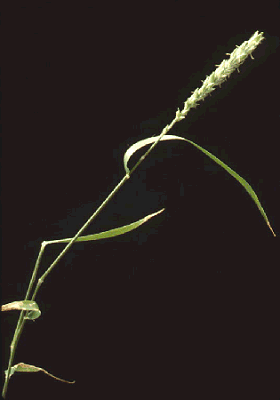Thyridolepis mitchelliana (Nees) S. T.
Blake. Contr. Queensland Herb. 13 :27 (1972).
Classification. (GPWG 2001) : Subfamily Panicoideae. Neurachneae.
Basionym and/or
Replacement Name: Neurachne
mitchelliana Nees, Hooker's J. Bot. Kew Gard. Misc. 2: 410 (1843).
Type of Basionym or
Protologue Information: T: Mitchell 46, 1836, Australia: interior of
New Holland [Lachlan River?] (CGE).
Recent synonyms:
Neurachne mitchelliana.
Key references
(books and floras): [1878] G.Bentham, Flora Australiensis 7 (508 as Neurachne
mitchelliana), [1952] C.A.Gardner, Flora of Western Australia 1 Gramineae
(273 as Neurachne mitchelliana), [1981] M.Lazarides in J.Jessop (ed)., Flora
of Central Australia (485), [2002] D.Sharp & B.K.Simon, AusGrass,
Grasses of Australia, [2006] J.Jessop, G.R.M.Dashorst, F.M.James, Grasses
of South Australia (504), [2008] S.W.L.Jacobs, R.D.B.Walley &
D.J.B.Wheeler, Grasses of New South Wales (385).
Illustrations:
[1952] C.A.Gardner, Flora of Western Australia 1 Gramineae (272,
Pl.78 as Neurachne), [2006] J.Jessop, G.R.M.Dashorst, F.M.James, Grasses
of South Australia (505, 3/fig. 433
& plate 18), [2008] S.W.L.Jacobs, R.D.B.Whalley & D.J.B.Wheeler, Grasses
of New South Wales, 4th edn (385).
Habit.
Perennial. Culms erect, 20–60 cm tall. Mid-culm internodes pubescent. Mid-culm
nodes pubescent. Ligule a fringe of hairs. Leaf-blades 1–6 cm long, 3–5 mm
wide.
Inflorescence.
Inflorescence solid, a raceme. Panicle linear, 2–4 cm long.
Spikelets.
Spikelets pedicelled. Fertile spikelets 2-flowered, the lower floret barren
(rarely male), the upper fertile, comprising 1 basal sterile florets,
comprising 1 fertile floret(s), without rachilla extension, elliptic, dorsally
compressed, 5–7 mm long. Rhachilla internodes elongated between glumes.
Glumes.
Glumes dissimilar, thinner than fertile lemma. Lower glume lanceolate,
coriaceous, without keels, 3–5 -nerved. Lower glume surface glabrous or
indumented. Upper glume elliptic, 4.5–6.5 mm long, coriaceous, without keels,
5–7 -nerved. Upper glume surface tuberculate, glabrous or indumented. Florets.
Basal sterile florets 1, barren, without significant palea. Lemma of lower
sterile floret 80 % of length of spikelet, herbaceous, 5 -nerved.
Fertile lemma 4 mm
long, without keel, 3 -nerved. Palea 2 -nerved. Anthers 3.
Continental
Distribution: Australasia.
Australian
Distribution: Western Australia, Northern Territory, South Australia,
Queensland, New South Wales.
Western Australia:
Austin. Northern Territory: Central Australia North, Central Australia
South. South Australia: North-western, Lake Eyre, Gairdner-Torrens
Basin, Flinders Ranges, Eastern, Eyre Peninsula. Queensland: Darling
Downs, Gregory North, Leichhardt, Maranoa, Warrego, North Kennedy, South
Kennedy, Gregory South. New South Wales: North-Western Slopes,
North-Western Plains, South-Western Plains, North Far Western Plains, South Far
Western Plains.
Notes.
The association of long villous hairs with setaceous hairs on the submargins of
the upper glume distinguishes this species. However, only spikelets on the
upper part of the inflorescence should be used, as drastic spikelet dimorphism
in a single inflorescence occurs. Additional important characters include
spikelet length, main axis length and length of the submarginal hairs.
In semi-arid shrub
woodlands, arid and semi-arid low woodlands, shrub steppe shrublands, acacia
shrublands, eucalypt shrublands, arid tussock grasslands, arid hummock
grasslands, and coastal grasslands. Flowers mostly Mar.-Sept., but sporadically
throughout the year.






